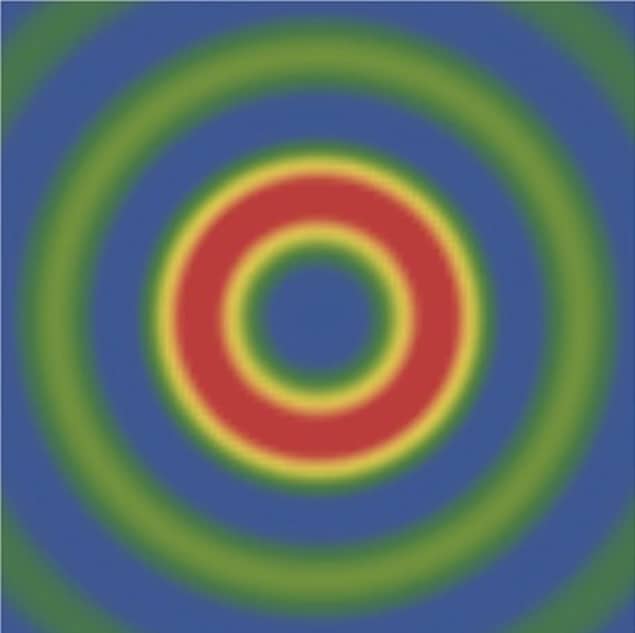
Physicists have taken another step forward in exploiting light’s vast unused potential as an information carrier. Researchers in Germany have calculated how “twisted” light beams can influence electrons inside hydrogen atoms via the beam’s orbital angular momentum. While the theory has not yet been confirmed in the lab, the team says that its work could lead to the development of a new way of storing and retrieving quantum information – something that could play a crucial role in the operation of future quantum computers.
Spin angular momentum is a familiar property of electromagnetic waves and it gives rise to light’s polarization. But electromagnetic waves – and indeed matter waves – can also possess what is known as orbital angular momentum (OAM), which means that a beam’s wavefront spirals around its propagation axis (in contrast to a plane wave, whose wavefront remains at right angles to this axis). Such a beam has an undefined phase and therefore has zero intensity at its centre.
First observed in 1992, OAM-carrying beams are known as twisted beams. They can now be routinely created in the laboratory using a variety of techniques that include the use of special holograms and phase plates. These beams are used in a number of areas of research, including optical communications. Indeed, researchers have shown that information-carrying beams with different degrees of twistedness can be transmitted simultaneously through a glass fibre, so increasing the transmission capacity of the link.
Twisted qubits
More futuristically, twisted beams might be used in quantum computers. These are devices that exploit quantum mechanics to operate on qubits – superpositions of 0 and 1. The idea would be to create qubits that are superpositions of two OAM states. Writing quantum information to the computer would involve firing a laser beam made up of photons in OAM superposition at a collection of atoms, so transferring the OAM to the atoms and storing the data. Reading out those data would then involve shining a second laser beam onto the atoms, in order to encode that beam with OAM information about the atomic state.
In the latest work, Oliver Matula of the University of Heidelberg and colleagues provide a general theoretical description of the interaction between twisted light beams and atoms. To do so, they calculate the angular distribution of emitted electrons when a twisted light beam impinges on and ionizes a hydrogen atom.
The researchers found that when the atom is placed close to the centre of the beam, the angular distribution is markedly different to that which would be produced by an incoming plane wave. In other words, the beam transfers its OAM to the electrons. However, when the atom is far from the beam’s centre, it turns out that the electron distribution is similar to that produced a by a plane wave. In this case, the researchers concluded, the twisted light beam exchanges only spin angular momentum with the electron.
Bessel beams
A theoretical description of interactions between beams of twisted light and atoms had already been published in 2010 by Jordi Mompart of the Autonomous University of Barcelona and colleagues in Spain. But that work considered a more limited class of “paraxial” waves that have a small transverse momentum. The latest work is more general because it describes the effect of so-called Bessel beams, which do not spread as they propagate and have a characteristic intensity profile made up of a series of concentric rings. These beams can, in principle, have arbitrary transverse momentum. Matula’s group calculated that when close to the paraxial limit an ultraviolet Bessel beam can transfer OAM to hydrogen atoms no more than about 100 Bohr radii (one Bohr radius being about 0.1 nanometres) from the centre of the beam, while in a non-paraxial state it can do so for atoms up to 10,000 Bohr radii from the centre.
James McGuire of Tulane University in New Orleans, US, who also works on the theory of twisted-photon–matter interactions, believes that the latest work is likely to contribute to applications in areas such as quantum information. But he cautions that experimental proof of this and related theoretical research will not come easily. “We are not yet at the point of testing these calculations, although I am optimistic that this may happen within the next few years,” he says, adding that “it is unfortunate that in this field there is not a closer relationship between people working in theory and experiment.”
Intense laser pulses
Mompart also praises the latest work, which he describes as an “excellent paper”, and agrees that it will be difficult to verify experimentally. “The ionization of atoms close to the vortex of an OAM light beam requires very intense laser pulses far beyond the limits of today’s technology,” he says. However, he adds that the Extreme Light Infrastructure, being developed in Eastern Europe, will have the required intensity.
Even with this experimental demonstration under their belts, physicists would still face significant additional hurdles in exploiting such OAM transfer inside a quantum computer. For one thing, Matula points out, the current work only considers the interaction of a twisted beam with a single atom and ignores the effect of the many other atoms that would be present inside a quantum computer. In addition, he says, thought would need to be given as to exactly how such interactions could be applied to specific quantum algorithms, such as the identification of a number’s prime factors.
The research is published in Journal of Physics B: Atomic, Molecular and Optical Physics.



